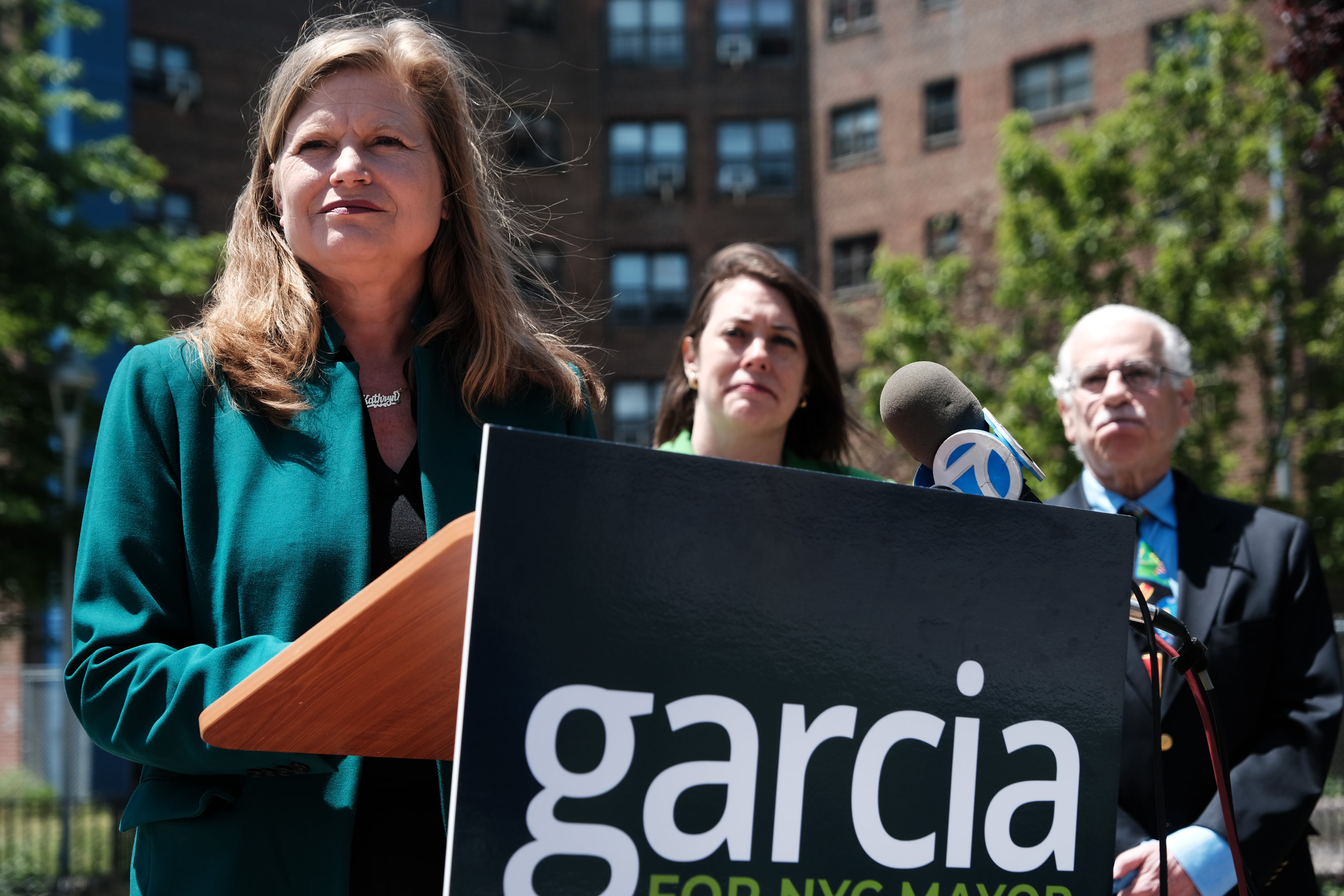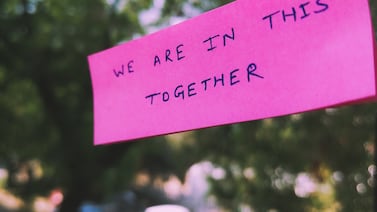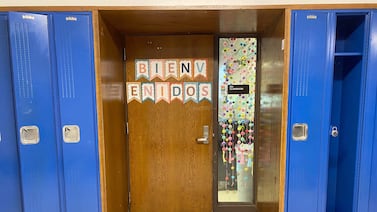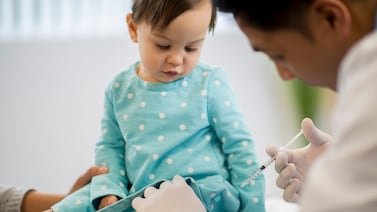New York City’s first-ever mayoral primary with ranked-choice voting was upended by the latest vote tally on Tuesday, as Kathryn Garcia appeared to gain significant ground on Democratic front-runner Eric Adams.
But hours after releasing the results that showed Adams’ lead shrinking, the Board of Elections acknowledged a “discrepancy” in the tabulations, sending the race into upheaval. The victor won’t be known until mid-July.
Tuesday’s results appeared to be a shot in the arm for Garcia, who has vowed to downsize the education department and move $130 million into principals’ budgets for teachers and other school-level priorities.
The former New York City sanitation commissioner has talked about moving money out of the education department and into schools, prioritizing the 140 schools where homeless students comprise 20% or more of the total enrollment. Garcia says she would also implement universal broadband across the city and a “Virtual Excellence” center at the education department, which would offer rigorous courses online, including Advanced Placement classes.
After the Board of Elections eliminated candidates and redistributed their votes from early voting and primary day, Garcia narrowed her margin to about two percentage points behind Adams — though the Brooklyn borough president is still favored to come out ahead, according to reports.
With tens of thousands of absentee ballots still left to be counted and another round of ranked-choice vote tabulations expected, the city may not have an official Democratic mayoral primary winner for weeks. But the victor of the primary is largely expected to become the next mayor of this heavily Democratic city.
A new mayor won’t take office until the middle of the next school year. But Mayor Bill de Blasio’s successor will still have a say on how to spend some of the massive federal COVID relief funds coming to New York City over the next few years.
Chalkbeat previously compiled where Garcia stands on some of the most pressing school issues, based on interviews and her education platform.
Integration efforts, Specialized High School Admissions Test and Gifted and Talented programs
New York City has the most racially segregated schools in the nation, and de Blasio’s administration has taken a piecemeal approach to address this.
Garcia is calling for more magnet offerings at every elementary school, providing additional opportunities for advanced learning targeted to students of color. She does, however, support eliminating Gifted and Talented testing for incoming kindergarteners while expanding the programming for other grade levels. The city has long tested 4-year-olds for seats in the city’s G&T, programs, serving roughly 16,000 elementary school students.
When it comes to the Specialized High School Admissions Test, an exam that is the sole admission criteria for eight of the city’s specialized high schools, Garcia would not eliminate it. Instead, she would build new high schools for students in the top 10% of their eighth grade class, prioritizing the South Brooklyn, Central Queens, and South Bronx neighborhoods.
She would, however, eliminate middle school screens and engage underserved parents in navigating the school system.
White and Asian students make up the majority of specialized high school programs as well as G&T, even though the city’s school system is majority Black and Latino.
Police in schools
New York City trails behind some other school districts in rethinking its approach to police in schools, though de Blasio promised to transfer oversight of school safety agents from the NYPD to the education department.
Garcia, who does not plan to defund the police, would retain school safety agents in schools but would move to reduce student arrests. “Black and brown children can’t experience school as a hostile environment focused on control and regulation,” her platform states. “We will better manage the school safety and discipline process so that students are not arrested for behavior that is best addressed by school officials or mental health professionals.”
Charter Schools
Charter schools, often a political lightning rod, serve roughly 140,000 NYC students.
Garcia supports lifting the cap on New York City charters. “Because you’re a charter school does not mean that I think you’re being selfish,” she said at a candidate forum for charter school parents in May. “It’s become too political, like you’re not pure enough on this or that. I just don’t feel that way.”
Plan for English Language Learners
More than 150,000 NYC students, or 15%, are designated as English Language Learners.
Garcia would leverage NYC Student Accounts and other forms of technology to make sure that parents have access to information in their preferred language. Her plan also states that she would invest in “high quality English language programs” for bilingual students.
Plan for students with disabilities
More than 200,000 students, or 20%, are classified as having disabilities that legally entitle them to receive special services in school. About 25,000 of these students who require more intensive support are in District 75, which exclusively serves students with special needs.
Garcia would expand access to service providers so families do not have to travel outside of their neighborhoods for support. She would also implement universal screening for dyslexia.
Plan for students in temporary housing
Roughly one in 10 students in NYC are homeless or live in temporary housing.
Garcia would expand support for the 140 NYC schools where more than 20% of students are homeless by providing wraparound supports. These services would include adult literacy courses, health clinics, and practical supports like access to a washer and dryer.
Child care access
While New York City has made dramatic strides in expanding access to preschool for 3- and 4-year-olds, challenges remain for many working families.
It can still be a struggle to find quality care for younger children. New York City has an estimated 15 slots for infant and toddler care per 100 children. Capacity went down in middle-income communities between 2011 to 2017, according to the advocacy group Raising NY.
And even those with children in the city’s free pre-K programs may face a child care crunch after the traditional school day ends around 2 p.m. and during summer break. City-subsidized preschool programs have pushed for more seats in centers that provide longer hours and care year-round.
Garcia said that extended child care hours should be available to “anyone who needs it to support them being able to go to work.” However, she stopped short of saying it should be universal.
She wants to expand free child care for low-income families and said building out the system should “accommodate what parents’ choices are going to be.” In New York City and across the country, child care is provided through a patchwork of home-based programs and center-based programs.
“So it is a plan that is multipronged and needs to move forward in a way that ensures that we are working with families to get them what they need,” she said.
Child care affordability
The expansion of universal pre-K for 4-year-olds saves New York City families an estimated $10,000 a year, according to the de Blasio administration. More and more students are also enrolling in free preschool for 3-year-olds, as the city expands its 3-K program to every school district next year. De Blasio is relying on one-time federal stimulus for the latest expansion, which still leaves the city about 20,000 seats short of reaching every 3-year-old.
Garcia proposes to offer free care for children from birth to age 3 to any family making under $70,000. She did not outline how the city would pay for those services but said strong early childhood care is “critical” to ensure students are ready for school and that families can work. The state legislature recently proposed a similar plan.
To help make sure more families can get the care they need, she said the city needs to streamline the voucher process “so that we’re not spending our time filling out forms, but spending our time making sure a kid is in that early childhood placement.” For example, she questioned why parents are repeatedly asked to go through an onerous process to verify their income levels when applying for different types of assistance.
Early childhood education workforce
Some preschool teachers who work in the city’s privately run, publicly subsidized pre-K programs are paid dramatically less than their counterparts in public schools, which can cause retention and recruitment challenges for programs. New York City has taken steps to address these gaps by boosting some teachers’ salaries by as much as $20,000 after educators threatened a strike.
But large disparities remain. Teachers who work for community-run pre-K sites don’t get the same pay bumps for longevity as public school teachers, and many work longer hours and throughout the summer. And the latest pay deals did not include teachers in certain special education pre-K programs, making those who work with some of the most vulnerable students among the lowest-paid teachers.
Garcia said that more equitable pay for early childhood educators also helps ensure that high-quality teachers staff centers. “I’m a big believer in making sure that we are creating a more equitable environment for everyone so that everyone can thrive,” Garcia said.
Any pay boosts, she said, would have to be a part of union negotiations and what’s known as pattern bargaining — when pay provisions negotiated by one union also apply to others.
But that didn’t happen when the city agreed to raise substantially certain pre-K teacher salaries in 2019. At that time, officials went around the normal contract negotiation process after teachers threatened to strike.
After-school and youth programs
Nonprofits that provide after-school and summer youth programs typically have to fight each year for their funding to be included in the city’s budget. Those programs have also been the target of cuts: When the pandemic first struck, the city slashed some 40,000 slots from the summer youth employment program, which provides paid internships to teens and young adults. The mayor’s proposed budget would restore funding for this summer.
Advocates have called for more stable funding for these programs to be built into the city’s budgets, so they and families can plan ahead. Many would also like to see summer youth employment expanded to become universal for any teen who wants a job, and for after-school care to be open to any student who needs it.
Garcia said she would expand after-school and other youth programs by tapping the American Rescue Plan, which earmarks billions of federal dollars intended to help students catch up from more than a year of interrupted learning due to COVID. She said nonprofits will be crucial partners in doing so and said she’d like to replicate models that incorporate work experience into their academic programs.
She said paid internships should be “available to anyone who wants it.” But she added that they should be “thoughtful opportunities” for youth “so that kids really have an idea about what the work world will look like.”








